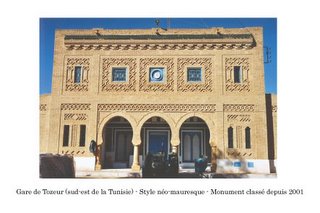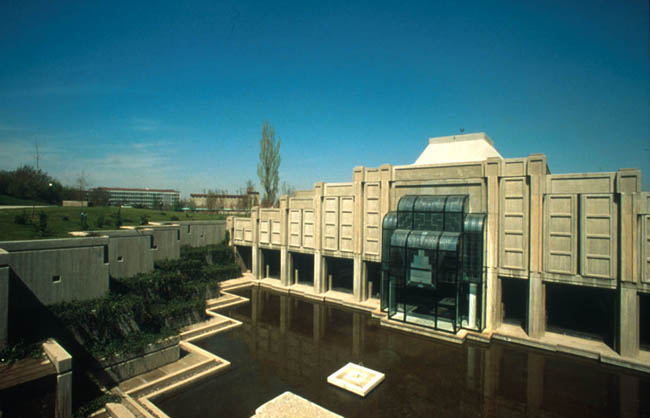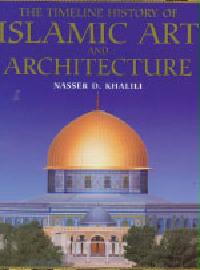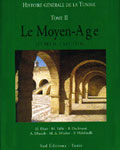
Qantara, a French journal of the Institut du Monde Arabe at Paris, published a in its 58th issue a series of articles on the city of Tunis. Under the topic of "Tunis la citadine" various articles were written including the history of Tunis and Colonial architecture.Exerpts of these articles are available through Qantara's website
Here they are:
Avant les commémorations…
Les commémorations sont toujours l’occasion d’examiner le passé, même si son image est demeurée figée telle une photographie jaunie. Elles peuvent aussi inciter à prendre la mesure du temps écoulé, à confronter celui-ci à d’autres temps plus anciens, à la veille du Grand Jour par exemple, mais aussi à l’avant-veille. Car l’histoire se récrit inlassablement.
En célébrant cette année le cinquantenaire de leur indépendance, la Tunisie et le Maroc jetteront un regard en arrière, il va sans dire. Les bilans qui seront dressés ici et là, différents, contradictoires voire véhéments, devront toujours être sous-tendus par une double interrogation sur l’identité et l’avenir.
On a choisi d’évoquer ici Tunis, la capitale qui a donné son nom au pays, puisque l’arabe ne distingue pas les deux noms, à l’instar du voisin de l’ouest. Métropole méditerranéenne devenue prospère bien avant l’intervention européenne, Tunis présente bien des traits communs aux villes portuaires : une activité industrielle tournée vers le commerce, la présence de colonies étrangères, un pouvoir soucieux des intérêts économiques et une perméabilité aux modes venues de l’étranger, qu’elles fussent turques ou européennes.
Il y a aussi bien sûr des traits spécifiques : la proximité de l’Italie s’est traduite par l’afflux précoce d’immigrés originaires de régions pauvres, siciliens notamment, et par une forte imprégnation dont on peut encore déceler les marques dans le nom des rues, les mots d’usage courant ou la cuisine. À cela s’ajoutent une présence juive millénaire, l’une des plus fortes du pourtour méditerranéen, et des colonies étrangères d’origine diverse, tels les Grecs qui ont essaimé partout depuis la nuit des temps.
Cette ville qu’on n’ose dire cosmopolite était entrée dans la modernité sans aide ni parrain avant de voir son histoire s’infléchir et son destin se déterminer à son insu. Jusqu’à une indépendance dont il sera beaucoup question au cours des moins prochains.
Histoire de Tunis aux cent visages
Héritière de Carthage, Tunis, surnommée « la Hâdhira » par les chroniqueurs tunisiens (littéralement la cité, la capitale), a vite relayé Kairouan, vieille capitale aghlabide, pour s'imposer comme une cité ouverte à l'Autre et à la mer et dont le dynamisme a sans cesse été recomposé grâce aux divers apports des peuples méditerranéens.
Deuxième ville du Maghreb occupée par les Arabes, Tunis n’était à l’origine qu’une petite bourgade numide qui passa ensuite sous l’autorité de Carthage. [...] Les sources arabes affirment que c’est Hassân Ibn Nu’mân en personne, le chef de l’expédition qui avait pris Carthage (698), qui s’empressa d’importer un millier de Coptes d’Égypte pour creuser un canal et faire venir la mer à Tunis. Protégée par le lac et le canal, Tunis était ainsi plus à l’abri que Carthage. [...]
Tunis capitale des Hafsides
Venus du Sud marocain, les Almohades mirent fin au morcellement politique de l’Ifrîqiya et l’englobèrent en 1159 dans leur vaste empire. Leurs gouverneurs, après s’être rendus indépendants, fondèrent la dynastie des Hafsides qui firent de Tunis leur capitale, y construisirent leur forteresse, la Qasaba et une mosquée dite des Almohades ou de la Qasaba. [...] L’économie prospère alors ; en témoignent les nombreux souks construits autour de la grande mosquée : le souk al-‘Attârîna (souk des parfumeurs) et le souk al-qumâch (souk des étoffes) datent de cette époque faste. L’organisation des souks obéit à une hiérarchie géographique : les souks « nobles » (étoffes, libraires, boutiques des notaires, ciriers, bijoux) sont proches de la grande mosquée, tandis que les plus bruyants et les plus sales sont renvoyés à la périphérie. [...] Selon différents témoignages, la ville comptait au XVe siècle près de 100 000 habitants ; au début du xvie siècle, Léon l’Africain évalue sa population à 10 000 feux. Mais le XVIe siècle apporta son lot de destructions. Devenue la proie des Espagnols, qui l’occupèrent entre 1535 et 1574, et des corsaires barbaresques installés à Alger, Tunis finit par tomber sous l’emprise des Turcs ottomans appelés à la rescousse par les corsaires.
Tunis capitale des Ottomans
Avec les Ottomans, la ville connut de nouveau une relative sécurité sous les règnes des Deys (1591-1647), des Beys mouradites (1631-1699) puis de la dynastie Husseynite à partir de 1705. Une véritable renaissance urbaine fut amorcée sous Youssef Dey (1610-1637) et poursuivie par les princes des dynasties suivantes. [...] Les communautés andalouses et les juifs d’origine ibérique dits Grana furent, avec les Turcs, des introducteurs de modernité dans la société tunisienne. Les premiers apportèrent avec eux de nouvelles techniques artisanales, commerciales et monétaires, les seconds, les armes à feu, les arts militaires et leur organisation administrative. Les citadins andalous débarqués d’Espagne se fixèrent dans la rue des Andalous, à l’ouest de la Médina, et dans le quartier des Andalous proche de la place Halfaouine. On doit à ces fins artisans musulmans l’industrie des « bonnets rouges », les chachiyya (chéchias), dont ils produisaient vers le milieu du XVIIIe siècle 40 000 douzaines par an, une activité qui occupait quelque 15 000 personnes (1). [...]
La prospérité du XVIIIe siècle
À partir de 1705, la dynastie des Beys Husseinites hérite d’une cité florissante et consolide l’œuvre déjà entamée tant sur le plan urbanistique qu’économique et culturel ; [...] Cet état de prospérité relative, Tunis le devait à un commerce florissant, à un « boom urbanistique » soutenu par les princes, et au transfert continu d’une large partie du surplus agricole vers la ville. [...] Au XVIIIe siècle, l’activité commerciale de la ville supplanta progressivement l’activité corsaire. L’implantation de négociants européens, principalement français et italiens mais aussi juifs livournais, renforça le cosmopolitisme de la ville. La ville aura donc développé à l’époque husseinite un urbanisme rompant avec le modèle de la cité traditionnelle repliée derrière ses remparts. L’essor démographique, les apports des communautés ethniques et religieuses, la diversité des emprunts de civilisation et de culture aboutirent au développement d’un cosmopolitisme spécifique qui finit par donner naissance, vers la seconde moitié du XIXe siècle, à un modèle original d’urbanisme et de citadinité. [...] Mais la peste de 1818 annonçait déjà pour Tunis la fin de la belle époque. La ville étant frappée de pénurie et menacée de famine, le Bey Mahmoud dut intervenir en 1819 pour assurer le ravitaillement en puisant dans les réserves de la Rabta (silos à blé). [...] L’administration beylicale, modernisée grâce à l’œuvre du ministre réformateur Kheireddine (1873-1876) et à celle du général Hussein (premier président du conseil municipal de la ville à partir de 1858), trahissait de son côté une inefficacité de plus en plus prononcée.
Tunis à l’ère coloniale : la ville bicéphale
À partir de 1881, avec la colonisation, la Médina de Tunis, vieille de plus d’un millénaire, ne répondait plus aux critères de modernité. Le quartier européen va s’agrandir depuis la ville basse autour de Bâb al-Bahr et donner naissance à la ville nouvelle, qui vient se juxtaposer à la ville musulmane, faisant ainsi de Tunis une ville double. [...]
C’est ainsi que Tunis est devenue le foyer de sédimentation d’une mémoire multiséculaire de toute une nation. Chaque monument et chaque recoin de la ville enregistrent des événements et une mémoire/histoire, laquelle à son tour charge ce corps d’une signification et de symboles précis. Des lieux sacrés, allant de la Zaytûna à la colline de Sidi Abul-Hassan al-Châdhuli, aux espaces profanes, de la ville basse à la Casbah, l’ensemble de cet espace constitue dans son unité un patrimoine exceptionnel par son histoire, par les apports multiples qu’il a su intégrer et par sa vocation culturelle. •
Abdelhamid Larguèche, professeur d’histoire, Faculté de la Manouba, Université de Tunis I
(Notes)
1. La production associait la capitale à un certain nombre de centres artisanaux de l’intérieur du pays, outre différentes régions méditerranéennes dont étaient importées les matières premières (laine d’Espagne, cochenille).
Les influences croisées de l'architecture coloniale
Les médinas de Tunisie ont été marqués, à travers les siècles du sceau d'une même configuration architecturale et décorative avec, de temps à autre, l'émergence d'éléments nouveaux. [...]
Des éléments typologiques nouveaux
Cette longue gestation intégrant de nouveaux éléments occidentaux s’accentue avec le début du Protectorat français en 1881 et la naissance de villes coloniales répondant à un principe d’urbanisation régulier. Les villes tunisiennes commencent ainsi à connaître une longue vague constructive faisant appel au savoir-faire d’intervenants (architectes, entrepreneurs, maçons, artisans) de diverses nationalités, révélant un important enrichissement artistique et l’apparition de nouveaux styles architecturaux et décoratifs. C’est donc dans un contexte moderniste et avec l’arrivée des Français qu’un paysage urbain inhabituel commence à se profiler et que des éléments typologiques nouveaux font leur apparition (façades sur rue richement décorées, vérandas, balcons, etc.). [...]
L’implantation d’une architecture extériorisée
Les nouveaux édifices d’époque coloniale introduisent une œuvre artistique étrangère à la Tunisie musulmane qui se traduit par l’implantation d’une architecture extériorisée, aux façades monumentales et richement décorées. Les constructions s’assemblent dans un mélange de styles caractéristique du pays tout en s’enrichissant les unes des autres et en créant des allures urbaines diverses aux contrastes frappants. [...]
Une architecture en péril
Ces constructions d’époque coloniale présentent actuellement des signes inquiétants de vieillissement et posent de graves problèmes de conservation. L’indifférence, la négligence, le manque d’entretien et de moyens financiers, les transformations incontrôlées ainsi qu’une forte spéculation foncière défigurent de manière irrémédiable le paysage urbain tunisien et participent à la disparition lente d’un patrimoine méconnu, pourtant exceptionnel. [...]
Récemment, l’idée s’est imposée de la mise en valeur et de la sauvegarde des bâtiments coloniaux d’importance majeure. La situation semble donc évoluer puisque, désormais, les anciennes aires européennes sont considérées par l’État comme faisant partie du patrimoine national. Différentes formes d’intervention sont ainsi établies pour leur préservation. [...]
Aujourd’hui, nombre de traces de l’époque coloniale ont disparu, tandis que d’autres s’estompent lentement pour laisser place à de nouvelles formes architecturales répondant à des tendances modernistes et que de nouveaux décors remplacent les façades et les devantures des édifices coloniaux, devenues désuètes. Ces choix se traduisent par une uniformisation du paysage urbain des villes tunisiennes et par la propagation d’un « style international » monotone et inadapté au climat. •
Chiraz Mosbah est doctorante à Paris IV-Sorbonne et assistante à l’Institut supérieur des Beaux-Arts de Sousse.
Modeler l'histoire : docile Carthage
Depuis 1956, l’État tunisien fraîchement indépendant se débat avec son histoire : comment concilier son appartenance au monde arabo-musulman et ses racines préislamiques – la Médina de Tunis et les ruines de Carthage étant les matérialisations respectives de ces deux univers ?
L’épineux problème est savamment résolu par un discours officiel multipliant les formules consensuelles du type « Tunisie, mosaïque de civilisations » ou « Tunisie, trois mille ans d’histoire ». Il n’empêche que de cette mosaïque d’histoires, certaines tesselles ressortent plus que d’autres. Aujourd’hui, c’est le passé carthaginois qui est à l’honneur. Et Hannibal, tout descendant d’une famille originaire de Phénicie, adorateur de Baâl, de Tanit ou d’Eshmoun qu’il fût, est érigé en héros national. [...]
Acrobaties identitaires
Le souvenir des Carthaginois est donc compatible avec la Tunisie contemporaine. Au début de son combat pour l’indépendance, Bourguiba, pourtant, en avait décidé autrement : l’évocation du passé numide, précisément parce qu’il renvoyait à la notion d’autochtonie, lui était apparue opportune. L’analogie entre Jugurtha, roi des Numides (118-105) résistant à l’occupation romaine, et lui-même, luttant contre la présence coloniale française, se voulait efficiente. [...]
La guerre des strates
On mesure dès lors combien l’archéologie, « science des monuments et autres témoins de civilisations disparues (3) », joue un rôle décisif dans ce travail de reconnaissance aléatoire. Les orientations de recherche et les résultats des fouilles entreprises guident et alimentent des controverses du présent. Avec l’indépendance, le service des Antiquités mis en place au lendemain de l’établissement du Protectorat français (1881) devient l’Institut national d’art et d’archéologie (1957) : commence la guerre des strates. Les bibles d’autrefois sont décriées : certaines conclusions de La Vie quotidienne à Carthage au temps d’Hannibal par exemple, de Gilbert-Charles Picard (4), directeur du service des Antiquités pendant la décennie précédant l’autonomie interne (1955), sont dénoncées comme colonialistes. La première génération de spécialistes tunisiens doit assumer dans l’urgence la charge du patrimoine, de l’histoire de son pays, avec un héritage supplémentaire à digérer, celui du passé colonial et de sa lecture de l’Antiquité. Une situation œdipienne est à gérer, filiation scientifique oblige. Rancœurs et reconnaissance d’une part, animosité et paternalisme – ou satisfaction et confraternité, selon les positions personnelles – de l’autre, l’archéologie avance malgré tout. La perspective est renversée, les données ne sont plus analysées depuis un double extérieur, formé à partir de la référence romaine et le fait de Français, mais à partir de l’intérieur, double lui aussi puisqu’il se place du point de vue des indigènes et qu’il peut être constitué par des Maghrébins (5). Un bouleversement historiographique s’opère pour ce qui est de la production artistique notamment ; là où le Carthaginois était vu comme le vulgaire emprunteur du savoir-faire hellénique, la nouvelle tendance en fait un créateur de génie (6). Les résultats des découvertes archéologiques contribuent à la révision de l’histoire. La litanie de Carthage sombrant dans des « siècles obscurs » à la chute de l’Empire romain explose : les documents épigraphiques et archéologiques découverts lors de fouilles récentes sur la colline de Byrsa attestent du dynamisme intense de la cité aux périodes vandale et byzantine. Le problème est qu’à mesure que progresse l’urbanisation à Carthage, la possibilité de réécrire l’histoire s’affaiblit. Les archéologues du futur pourront apprécier le dynamisme de la banlieue chic, l’opulence de ses villas et la vastitude de ses parkings ; ils observeront de ce fait que la législation internationale protégeant ce parc archéologique ne constitue en aucun cas un obstacle à l’expression d’enjeux économiques et politiques omnipotents. •
Clémentine Gutron est doctorante en histoire à l’EHESS, allocataire de recherche à l’Institut de recherche sur le Maghreb contemporain (IRMC, Tunis)
La suite de cet article est à lire dans Qantara 57
 Louis Kahn's Richards Laboratories, University of Pennsylvania: 1965
Louis Kahn's Richards Laboratories, University of Pennsylvania: 1965 Hassan Fathy New Gourna Mosque, 1946
Hassan Fathy New Gourna Mosque, 1946














